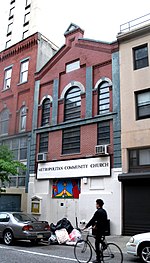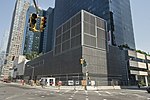Baryshnikov Arts Center
2005 establishments in New York CityConcert halls in New York CityCulture of ManhattanHell's Kitchen, ManhattanMusic venues in Manhattan ... and 3 more
Off-Broadway theatersPerforming arts centers in New York CityTheatres in Manhattan

The Baryshnikov Arts Center (BAC) is a foundation and arts complex opened by Mikhail Baryshnikov in 2005 at 450 West 37th Street between Ninth and Tenth Avenues in the Hell's Kitchen neighborhood of Manhattan, New York City. The top three floors of the complex are occupied by the Baryshnikov Arts Center, which provides space and production facilities for dance, music, theater, film, and visual arts. The building also houses the Orchestra of St. Luke's DiMenna Center for Classical Music.
Excerpt from the Wikipedia article Baryshnikov Arts Center (License: CC BY-SA 3.0, Authors, Images).Baryshnikov Arts Center
West 37th Street, New York Manhattan
Geographical coordinates (GPS) Address External links Nearby Places Show on map
Geographical coordinates (GPS)
| Latitude | Longitude |
|---|---|
| N 40.756044 ° | E -73.997363 ° |
Address
West 37th Street 450
10018 New York, Manhattan
New York, United States
Open on Google Maps








